|
back to spaceweather.com |
| Summary: The 2006 Perseid meteor shower peaked on August 12th in bright moonlight--so much for dark skies! Nevertheless, sky watchers managed to photograph some nice shooting stars, as shown below. This
is Page 1 | Page 2 |
| Photographer, Location | Images | Comments | |
|

|
Stan
Nelson, Roswell, NM Aug. 12 |
audio file | Radio engineer Stan Nelson recorded a loud ping when a Perseid meteor streaked over the Naval Space Surveillance Radar in Kickapoo, Texas. The Naval Space Surveillance Radar scans the skies above Texas with a 217 MHz radar beam. Whenever anything passes overhead, the radar produces an echo which can be picked up by receivers hundreds of miles away. Nelson recorded the Perseid ping from his listening station in Roswell, New Mexico. |
|
|
Jim Gamble, El Paso, Texas Aug. 10 |
still image: #1 |
Jim Gamble photographed this "nice, bright and long magnitude -8.6 Perseid" using an all-sky camera at the El Paso Station of the Sandia All Sky Camera Network. |
|
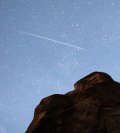
|
Thad
V'Soske, Colorado National Monument Aug. 10 |
#1, more | It took an exceptional Perseid to compete with 95% moon illumination and, fortunately, my camera was in position to capture its demise at 10:54pm MST on August 10, 2006 (Canon 20D, 3200ISO, 24mm @ f/2.8 for 30-seconds). |
|
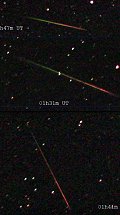
|
Pete
Lawrence, Selsey, UK Aug. 12 |
#1, more | Despite a bright Moon, I decided to try to capture some Perseid meteors. This was very much a balancing act as the camera's sensitivity had to be set high in order to stand a chance of recording these swift streaks of light, but the exposure kept short to avoid overloading the image with moonlight. In the end I opted for 20s exposures at ISO3200 with the lens at wided aperture. Out of ~500 frames, I've so far managed to record 3 perseid meteors. Interestingly the camera has caught their multi-coloured appearance well. Why do they look like this? Well it's all to do with the way they 'burn-up' or ablate in the atmosphere, the multi-coloured appearance being due to the particles sublimated from the meteoroid exciting atoms in the atmosphere. And what of that interfering Moon. Well, it's still very beautiful so I suppose it's forgiven! |
|
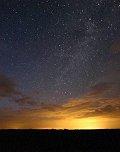
|
Jason A.C. Brock,
Roundtimber, Texas, USA Aug. 11 |
#1, more |
One faint meteor peaks from behind the clouds (above the light tower between clouds) as clouds and rain roll in to spoil the meteor shower on the peak night for Western north Texas. Next year will be better! This pic is also taken less than 30 miles from the Kickapoo NAVSPASUR station. Digital Rebel, 400 ASA, 30s |
|

|
George Varros,
Mount Airy, Maryland Aug. 12 |
#1 |
Imaged with a Stellacam II and home-made wide-field lens. Integration of two 8.5 second images. |
|
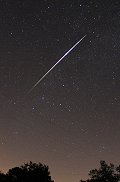
|
Chuck
Hunt, Dark sky near Mansfield Ohio Aug. 12 |
#1, #2 | Observed for an hour, this meteor came at 10:05 PM. Moon wasn't up yet. It seemed to be a slow mover and appeared orange. Beginning of trail has a rainbow of color. Canon Rebel XT with 15mm lens at f/2.8, 15 seconds at ASA 1600. |
|
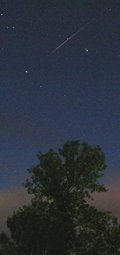
|
Conor
McDonald, Northern Ireland Co.Derry Aug. 11 |
#1 | Last night we started at 11pm and did an annual watch the night before the perseids. The rate was very good as we seen 30 and some bright ones. I caught this (ursa) major Perseid in a quiet spell! I think we could be in for a show tonight! |
| more images: from Marko Vidovic near Ptuj, Slovenia |


